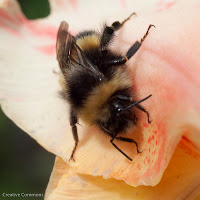
The magazine Vlinders of this month (3/09, the journal of the Dutch butterfly foundation—they also include working groups on dragonflies and the like) has an article on photographing dragonflies by Kim Huskens, from which I’d like to copy some of the many[!] sensible suggestions.
Camera talk
Apart from the usual arguments about technical pros and cons of DSLR’s versus compact cameras, they include some things specific to photographing insects and especially the fast-flying types, such as dragonflies.
Starting with flying fast: you need a camera that reacts very quickly, both when it comes to focussing and to the delay between pushing the button and the actual picture. Most of the time, DSLRs win out on these points from compacts. However, some of the newer ‘megazoom’ or ‘bridge’ cameras score very well on these points, too—Huskens does not mention those, and I admit I’m not aware of the state of the art either, but with 30+ pictures per second, or HD video options, you’d stand a good chance of capturing that dragonfly that the DSLR-amateur misses with ‘only’ 3-6 frames per second.
Another advantage of compact cameras lies in what often is a disadvantage: their small sensor. For that means they also have a large depth of field: you can make great pictures of insects in their environment and get a great view of the environment. Their disadvantage is of course that you cannot get that insect free from the optically disturbing background.
 For the rest of this blog, I am thinking of a DSLR, because now we get to changing lenses). Often, you’ll have to get close to get the beast filling a good deal of the screen/viewfinder. With special tele-macro lenses, you don’t need to get that close; with a normal 50 or 90 mm you’d have to get within a couple of centimetres of the target and they do not often wait for that… Bumble bees may sometimes be slower, early in the day or when they are cold, so the secon picture was made with a 50mm macro lens (thanks to the crop factor, that was 75 mm equivalent on a full-frame (D)SLR). The pictures in Huskens’s article were made with, I suppose, the famous Sigma 2.8/150 lens (she does not say if it is the current 2.8 version). For me with my Minolta/Sony stuff, there is the Tamron 3.5/180, with the advantage of a bit longer focal range. High on my wish list, because getting a dragonfly filling the viewfinder in real is better than using my 100-300mm at around 1.5 meter and cropping afterwards (as I did in the first picture here).
For the rest of this blog, I am thinking of a DSLR, because now we get to changing lenses). Often, you’ll have to get close to get the beast filling a good deal of the screen/viewfinder. With special tele-macro lenses, you don’t need to get that close; with a normal 50 or 90 mm you’d have to get within a couple of centimetres of the target and they do not often wait for that… Bumble bees may sometimes be slower, early in the day or when they are cold, so the secon picture was made with a 50mm macro lens (thanks to the crop factor, that was 75 mm equivalent on a full-frame (D)SLR). The pictures in Huskens’s article were made with, I suppose, the famous Sigma 2.8/150 lens (she does not say if it is the current 2.8 version). For me with my Minolta/Sony stuff, there is the Tamron 3.5/180, with the advantage of a bit longer focal range. High on my wish list, because getting a dragonfly filling the viewfinder in real is better than using my 100-300mm at around 1.5 meter and cropping afterwards (as I did in the first picture here).Making the picture
With insect photography, there are a few special things to think about. When you get close, you must take care not to cast your own shadow in the photo. Apart from losing a few stops of light, you’d scare off the dragonfly before you can press the button. So keep the sun behind you (for getting the detail of the animal) but not straight behind. Don’t try backlight.
Walk slowly and keep your distance while circling to a good angle. Huskens advises to get low, so that you don’t seem so big and threatening.
 For determining the dragonfly (if you can…): keep in parallel to the long body (not as in the third picture) so that it I sharp from front to tail. Often you need to see both the side and the top of the dragonfly’s body; sometimes you need two photos, then.
For determining the dragonfly (if you can…): keep in parallel to the long body (not as in the third picture) so that it I sharp from front to tail. Often you need to see both the side and the top of the dragonfly’s body; sometimes you need two photos, then.It helps to know the behaviour of the dragonfly: some families of dragonflies sit still quite a bit, others keep coming back to the same spot after short hunting flights, but there are also families that keep flying—obviously, those are the hardest.
Shoot first, ask later
‘Shoot first, ask later’ is one of my favourite one-liners when it comes to taking photos: when you see something promising, release the button as soon as you can, so that you have at least one memento of what you wanted to put in the picture. Only then begin to follow all the rules and tips to go for a good picture. Especially with dragonflies and the like, if you begin slowly, you may miss your one and only chance to get the beast at all.
No comments:
Post a Comment